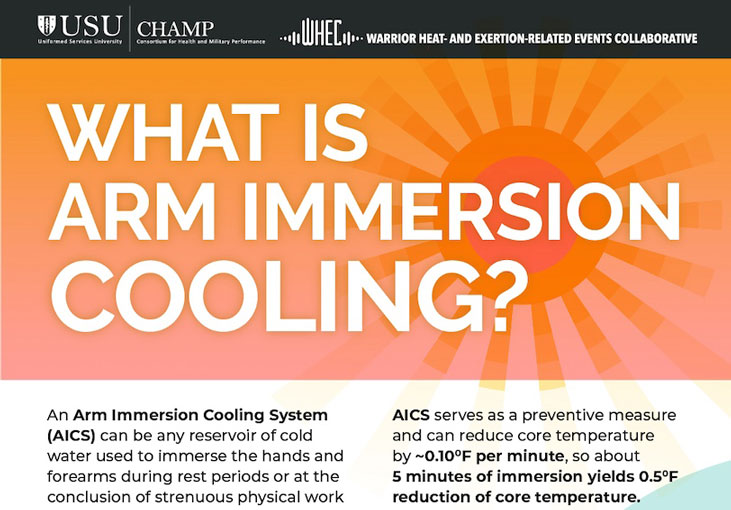An Arm Immersion Cooling System (AICS) can help reduce core temperature for those experiencing symptoms of heat illness or after prolonged exposure to high temperatures. Learn how to set up and use AICS to speed up body cooling.
You can also download a 508-compliant, print-friendly version of the Arm-Immersion Cooling graphic [PDF].

What is arm immersion cooling?
An arm immersion cooling system, or AICS, can be any reservoir of cold water used to immerse the hands and forearms during rest periods or at the conclusion of strenuous physical work in warm environments.
AICS serves as a preventive measure and can reduce core temperature by about 0.10 degrees Fahrenheit per minute, so about 5 minutes of immersion yields 0.5 degrees Fahrenheit reduction of core temperature.
Cooling time for a water temperature of 35 to 44 degrees Fahrenheit is 3 to 5 minutes.
Cooling time for a water temperature of 45 to 54 degrees Fahrenheit is 5 to 8 minutes.
Cooling time for a water temperature of 55 to 70 degrees Fahrenheit is 8 to 12 minutes.
Cooling time for a water temperature of 71 to 80 degrees Fahrenheit is 12 to 15 minutes.
Replace water when its temperature is greater than 80 degrees Fahrenheit.
Times are calculated to achieve about 0.5 degrees Fahrenheit reduction in body temperature. Failure to maintain proper water temperature or immerse the arms for enough time will diminish the effectiveness of the device.
One AICS component is a cooling system. While cooling systems are available commercially, they might not be available in every training scenario. Try other solutions instead such as a large cooler, large water trough, or locally fabricated solutions.
Follow the steps to set up a cooling system. First, choose any insulated container that can hold at least 20 gallons of ice water with enough space for immersion of forearms or arms. Fill the container with 20 gallons of ice water. Next, insert a thermometer into ice water to monitor its temperature.
Here’s how to use AICS. Submerge hands and forearms (up to biceps) in ice water. Keep hands and forearms submerged for the approximate amount of time and temperature range to accelerate body cooling. Next, raise arms above head to allow water to drip down to core.
Published on: December 7, 2022
References
DeGroot, D. W., Kenefick, R. W., & Sawka, M. N. (2015). Impact of arm immersion cooling during ranger training on exertional heat illness and treatment costs. Military Medicine, 180(11), 1178–1183. doi:10.7205/milmed-d-14-00727
House, J. R. (1998). Extremity cooling as a method for reducing heat strain. Journal of Defence Science, 3(1), 108–114.
Li, J. (2021). How to prevent heat injuries in military training. Retrieved 2 November 2022 from https://www.qoreperformance.com/blogs/military-insights/exertional-heat-illness-heat-offloading-techniques





